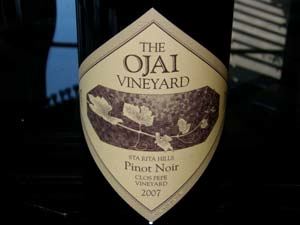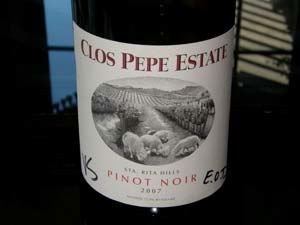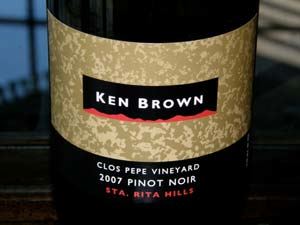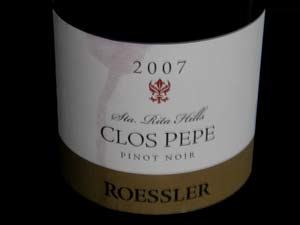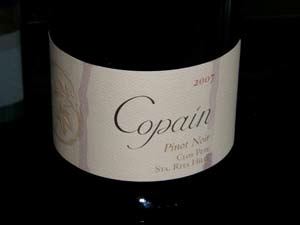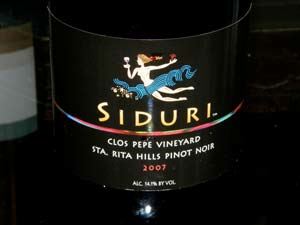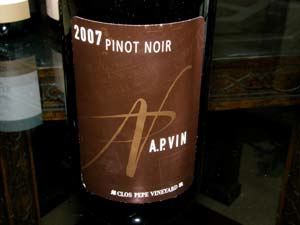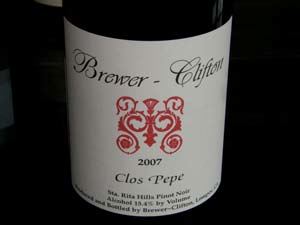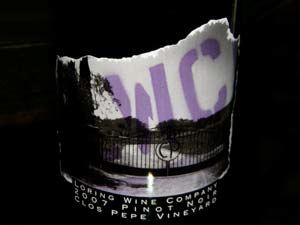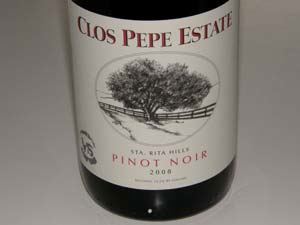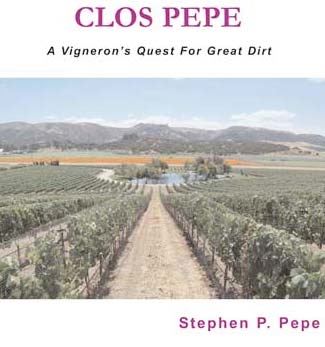Clos Pepe: A Grape named Pinot, a Vigneron, a Facilitator, a Dead Head, a Dog named Bud, and a Horse named Charlemagne
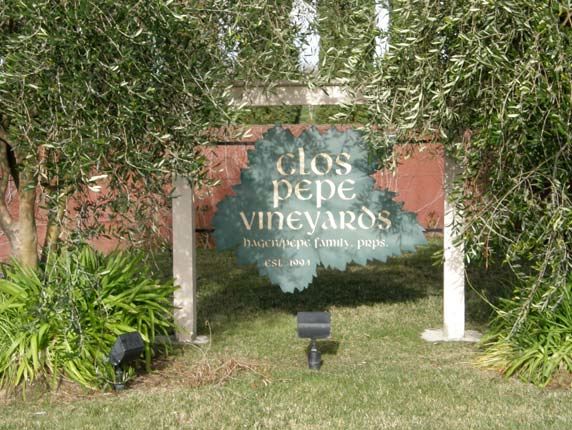
The Clos Pepe story begins with a familiar ring. Stephen P. Pepe grew up in northern New Jersey in a second generation
Italian American family whose love of vino was ingrained in their heritage. His grandfather had emigrated from a village destroyed by the eruption of Mt. Vesuvius and was a respectable home winemaker. Stephen developed an interest in the grape as well, dreaming of one day owning his own vineyard. Years of
education intervened as well as a successful career as a partner in an international law firm. Eventually his
new found discretionary income allowed him to collect and drink wines of the Cabernet Sauvignon persuasion,
but he was to soon develop a higher passion for the “infant terrible” of the wine kingdom, Pinot Noir. In 1990,
Stephen married Catherine Hagen, another partner in the law firm at which Stephen worked, a seminal event that was to take the Clos Pepe story on an adventurous path to the fulfillment of Stephen’s dream.
Catherine and Stephen moved into a small and unimposing house in Long Beach, California, an improbable
site for the birth of Clos Pepe. Stephen’s marriage had inspired him to pursue his lifelong dream to be a
vigneron. He said, “For many people, and I must be one of them, love and marriage provide just the inspiration
and impetus one needs to fulfill what was once merely an elusive fantasy.” The plans for a vineyard in the
backyard were hatched with Catherine’s unwitting blessing. The vineyard’s name originated from the cinder
block wall surrounding the yard (“clos” means enclosure in French). Undeterred by the fact that there was no
historical record of a viable vineyard in Long Beach, and possessing only the rudiments of viticultural
knowledge, the Pepe’s planted 24 Sauvignon Blanc and 30 Pinot Noir vines in their backyard. The first harvest
in 1991 yielded a grand total of four bunches of grapes. The experience, however, had the Pepes hooked on
winegrowing.
Undaunted, the Pepes brought in noted vineyardist, Jeff Newton, of Coastal Vineyard Care, to consult on Clos
Pepe. This was tantamount to asking the Pope to stop by your house to read you some scripture. Once Jeff
had recovered from his amazement upon visiting Clos Pepe and tendered some advice, he told the Pepes that
the Lompoc area of the Santa Ynez Valley on Highway 246 or Santa Rosa Road would be an ideal region for growing Pinot Noir. Stephen had visions of a commercial vineyard which would keep him challenged and
interested, yet providing him a place to eventually retire and find time to travel. He knew he wanted to grow
Pinot Noir and Chardonnay, and the western Santa Ynez Valley seemed to be a perfect fit.
When Stephen and Catherine began a search in earnest for property in the early 1990s, there were just three
wineries and five growers in the Lompoc area. The region, known as the Santa Rita Hills, was not to become
an approved American Viticultural Area until 2001. Several properties became available in the viticultural area
but for various reasons either seemed unsuitable or the Pepes were outbid by others. These properties
became Zotovich Family Vineyard, Rozak Vineyard, Ampelos Cellars and Melville Winery. Serendipity would
eventually shine on the Pepes, who acquired a 40-acre horse ranch in Lompoc located just west of Babcock
Winery on Highway 246. Escrow closed on December 7, 1994, one day before the Pepes’ fourth wedding
anniversary. The property was enclosed, albeit by a horse fence, so the name Clos Pepe could still be
invoked. The property’s wide-body trailer was suitable for temporary living and a large horse barn had the
potential to be be converted into a permanent home. A dream that began as a tiny backyard vineyard in Long
Beach, would become Clos Pepe Vineyards and Estate Wines.
The superficial soils at Clos Pepe were ideal for Pinot Noir and Chardonnay, composed of well-draining
calcareous shale with some sandy loam (the region had been under the ocean at one time). Unbeknown to
the Pepes, there was a hard pan located several feet from the surface which would deter vine roots from
penetrating deeply, discovered after an attempt to grow pumpkins on the property failed. This potential obstacle
was circumvented by deep ripping of the soil before planting. For a full discussion of the soils and microclimate
of Clos Pepe Vineyard, consult the Clos Pepe website at www.clospepe.com. Under the direction of Jeff
Newton, fourteen acres of Chardonnay went into the ground in 1994 using four clones: Davis 4 and 5, Dijon 76,
and Wente. Two years later, fourteen acres of Pinot Noir were planted to four clones: Dijon 115, 667 and 777
and Pommard using an 8’ x 4’ spacing. Because of poor ripening, in 2001, 10 acres of Chardonnay planted to
Davis clones 4 and 5 were budded over to Dijon clones 115 and 777 of Pinot Noir leaving 4 acres of
Chardonnay and 24 acres of Pinot Noir. 650 Tuscan olive trees were added to embellish the landscape and
provide the source for olive oil which would become the source for an award-winning commercial product along
side Clos Pepe Estate wines.
The Santa Rita Hlls is a western sub-appellation of the much larger Santa Ynez
Valley viticultural appellation located between the towns of Buellton and Lompoc in
Santa Barbara County. The eastern edge of Sta. Rita Hills is about four miles west
of Highway 101 in Buellton, and continues to the western boundary, about two miles
east of Highway 1 in Lompoc. The southern boundary is the North side of the Santa
Rosa Hills, with the northern boundary the South side of the Purisima Hills.
Officially, the Santa Rita Hills appellation is Sta. Rita Hills, since Vina Santa Rita, a
123-year-old winery in Santiago, Chile, threatened to file suit in 2001 to stop
California vintners from using the Santa Rita Hills name. The name, Sta. Rita Hills,
was officially adopted in 2006, and is pronounced the same, but reads a little
awkwardly. The Sta. Rita Hills appellation is the only region along the Pacific
coastline where the mountains run true east-west instead of north-south. The two
east-west oriented valleys centered by Santa Rosa Road and Highway 246 create a
gap that allows cooling Pacific Ocean winds to flow inland. When it is hot in Santa
Ynez which is forty miles to the East, it is 20 degrees cooler in the western Sta. Rita
Hills. Fog hovers over the vines until mid morning, and the temperature barely rises
above 75 degrees in the western reaches of the appellation. Mid day cooling winds
off the Pacific Ocean are common, often gusting at 20 to 30 miles-per-hour.
The Sta. Rita Hills appellation spans 30,720 acres (100 square miles), making it one
of the smallest viticultural appellations in California. Over 2,000 acres are planted
to grapes, mostly Pinot Noir with smaller amounts of Chardonnay, Pinot Gris, Pinot
Blanc, Gewurztraminer, Riesling and Syrah.
A map of the Sta. Rita Hills appellation with locations of important vineyards and
wineries is on the Sta. Rita Hills Winegrowers Alliance website at
www.staritahills.com. The map below, taken from the Clos Pepe website,
www.clospepe.com, shows the outline of the larger Santa Ynez Valley viticultural
appellation and the enclosed smaller Sta. Rita Hills viticultural appellation.
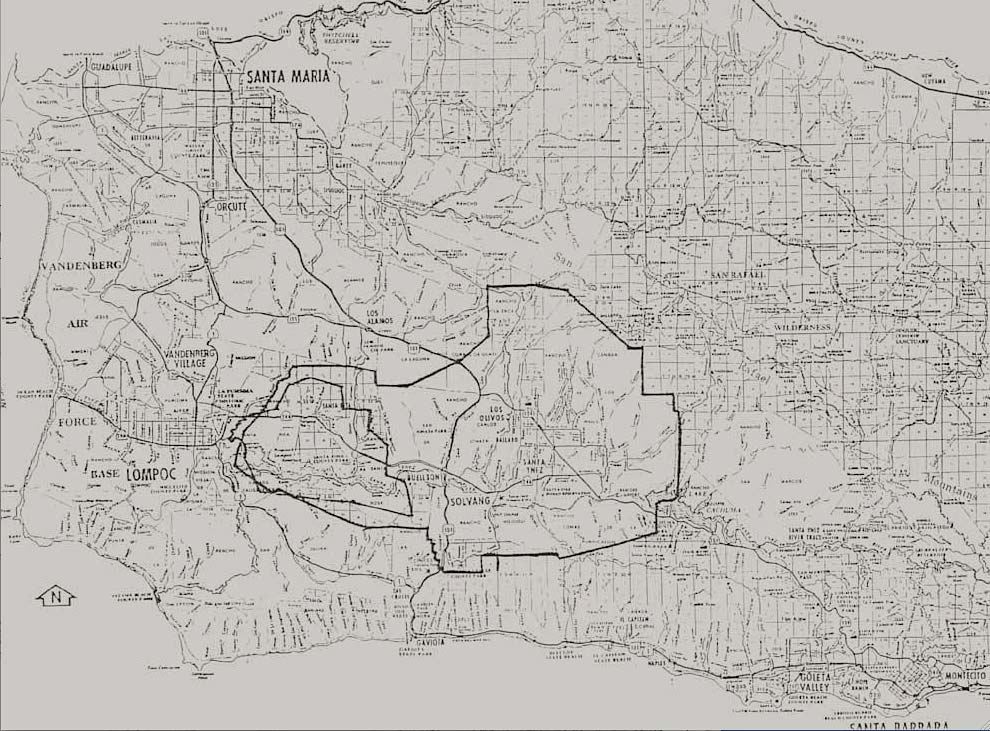
In 1994, Catherine’s second son, Wesley (pictured below), had moved onto the property as a caretaker while
the Pepes continued to make the many weekend trips from Long Beach to Lompoc. His official title was
“Scholar-in-Residence,” as he was a graduate of the University of Redlands with a degree in English and had
set about writing the Great American Novel. His musical interests veered to the Grateful Dead and his drink of
choice was beer (Stephen notes, “He didn’t know the difference between Grand Cru Burgundy and root beer”).
In 1996, wine had begun to pique Wes’s interest and he offered to assist Stephen with his home winemaking
career which dated back to the 1991 vintage. Stephen had acquired grapes each harvest from various Santa
Ynez Valley sources and produced both forgettable and unforgettable Cabernet Sauvignon-based wines
through these formative winemaking years.
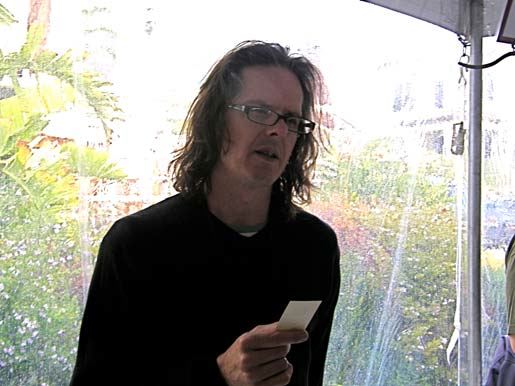
Wes worked the 1996 crush at neighboring Babcock Winery and this experience convinced him that he wanted
to pursue a career as a winegrower and winemaker. As fate would have it, Jeff Newton was heavily involved in
distant vineyard projects and no longer could manage the Clos Pepe Vineyard, departing in 1996. The Scholarin-
Residence put aside the Great American Novel, and stepped in to become the vineyard manager and
winemaker for Clos Pepe.
Wes’s aspirations were fueled by the success of a 1997 vintage Cabernet Sauvignon sourced from Knight’s
Valley and Edna Valley which won a Best of Show Award at the Orange County Fair Wine Competition, and the
Clos Pepe Chardonnay he made in 1998 from the vineyard’s fourth vintage. Wes experienced a revelation in
1998 when he accompanied Stephen to a tasting of the 1995 vintage wines of Domaine de la Romanee-Conti
put on by the Chevaliers du Tastevin in Los Angeles. Stephen was to reminisce, “Wes spent most of the
evening furiously scribbling pages of notes and, when there was a pause in the conversation, peppered Mr. de
Villaine with questions. Wes gushed about the wines for several days.”
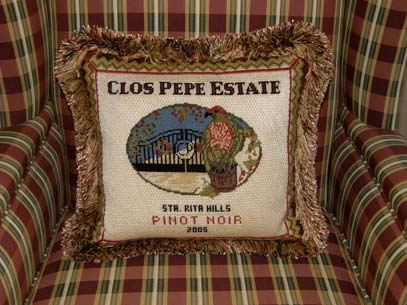
By 2003, Stephen and Catherine had tired of commuting to Clos Pepe
north in Lompoc from Clos Pepe south in Long Beach each weekend
and made a permanent move to their Sta. Rita Hills estate. Catherine
set about directing the conversion of the property’s horse barn to a
Tuscan-styled villa while maintaining her position with the law firm until
2005 to provide the capital for the undertaking. Her needlepoint
pillows and wall decor became a central theme of the interior decor.
“Theme park” embellishments were added to the property over time,
including the first bocce court in the Santa Rita Hills, a basketball
court, a horseshoe pit, a skateboard ramp, and a roller skating rink.
Stephen set off to learn more about viticulture, attending courses at
University of California Davis with Wes. Stephen would be the first to
admit that he was “winging it” when it came to many viticultural decisions at Clos Pepe, but he gained
invaluable experience which was to lead to ultimate success.
Over time a menagerie of animals found a home at Clos Pepe, including six dogs: Bud and Samson, both
Dalmatians, Winston, a pug, Rosa, a border-collie, and Indy and Tiva, both greyhounds. It was Bud that was
most special since he had been with the Pepes since their days in Long Beach. Bud was obsessed with
catching the ducks that lived on the pond of the property but in eight years of trying he was never successful.
Stephen described the dog’s frustration, “The ducks had a clever strategy in which the male ducks would circle
around the females, then one male would peel off as a lure to Bud, who would go after him. Unfortunately,
Bud’s doggy paddle was no match for the mallard’s ducky paddle. If Bud got too close, the decoy duck would
simply take wing and fly about 10 feet to safety. Bud voiced his protest at this ‘fowl play’ by barking furiously at
the injustice of it all.”
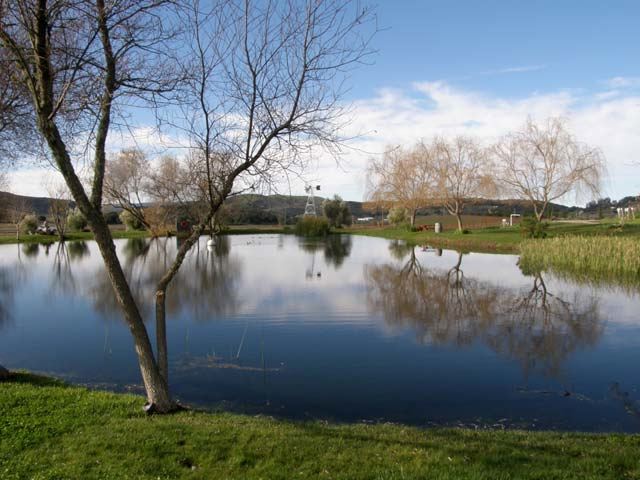
The 2000 vintage brought two significant developments. The inaugural commercial release from Clos Pepe
Estate was warmly received by wine critics, and Wes got married. Wes met his wife, Chanda, at concert where
a Grateful Dead-wannabe band called Family Dog was playing. She had a bottle of wine in hand, and the two
hit it off immediately. Before long she and her horse, Charlemagne, had taken up residence at Clos Pepe and
the couple were married in the midst of Clos Pepe Vineyard on a sunny and blissful September day.
The Pepes found an eager market for their grapes and the demand was a source of pride for the Pepes.
Clients for Chardonnay included Babcock Winery, Hartley-Ostini Hitching Post Winery (vineyard designated
and sold at the Hitching Post Restaurant), Brewer-Clifton Winery (now bottling Clos Pepe Chardonnay under
the Diatom label), Longoria, Ojai Vineyard, and Roessler Cellars. As the Pinot Noir vines came into production,
demand for Clos Pepe grapes was also exceedingly high. Wineries sourcing Pinot Noir over the years have
included A.P. Vin, Arcadian, Bonaccorsi Wine Company, Brewer-Clifton Winery, Carr Vineyards, Copain, Ken
Brown, Kenneth Crawford, Hartley-Ostini Hitching Post Winery, Loring Wine Company, The Ojai Vineyard,
Roessler Cellars, Siduri and Tyler. Today, Clos Pepe sells 75% of the grapes, retaining 25% of their output for
their own estate wine program.
In early February of 2010 I joined Stephen Pepe, Wes Hagen, and Eric Anderson (Grape-Nutz and Grape
Radio) at Stephen’s home for a horizontal tasting of all the 2007 Pinot Noirs produced from Clos Pepe
Vineyard in 2007. The tasting was quite informative because the ten wines were tasted in chronological order
according to when the grapes had been picked during harvest, from the earliest pick (Ojai) to the latest pick
(Loring). The wines were noteworthy for showing the marriage of high natural acidity and moderately high
natural alcohol, typical of Pinot Noir from the Sta. Rita Hills. The early picked wines showed crisp and juicy
cherry and raspberry fruits with prominent minerality and were more terroir driven. The later picked wines
displayed more blue and black fruits, sweet and sappy flavors, notes of tar and creosote, were less nuanced,
and were more barrel and style driven.
Winemaking at Clos Pepe Estate is non-interventional and dictated by the work that goes into growing grapes
that allows picking at optimal ripeness. A cold soak of 2-3 days is followed by fermentation in small open-top
fermenters initially with native yeasts followed by inoculation with RC-212 yeast. The wine is raised in 25% to
50% new French oak barrels, aged for 11 to 19 months, and minimally fined with little or no filtration.
Production of Clos Pepe Estate wines is as follows: 800 cases of Pinot Noir, 75 cases of Vigneron Select Pinot
Noir, and 150 cases of Chardonnay. In drought years production is reduced by 50 to 100 cases and in wet
years like 2005 production is higher by the same amount. In 2008, two-thirds of the vineyard crop was lost due
to frost resulting in a yield of two-thirds tons per acre. Because there were a dozen or so extra uncommitted
barrels, a second label called Axis Mundi was started using Syrah from Sleepy Hollow Vineyard in the Santa
Lucia Highlands. This is a food-friendly wine that avoids the trap of high oak, high tannin, high alcohol and
over ripeness found in many California Syrahs. 300 cases were produced. The Syrah was so well received, the
wine was also produced in 2009. In 2010 a white wine from Chenin Blanc grapes is being contemplated.
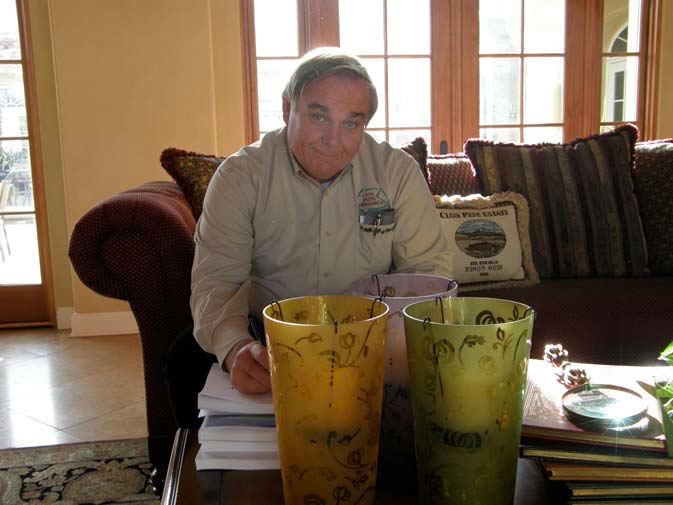

2007 The Ojai Vineyard Clos Pepe Vineyard Sta. Rita Hills Pinot Noir
14.0% alc., $37.40. 100% Pommard clone. Beginning with the 2009
vintage, Ojai will be replaced by Arcadian.
·
A delicate style which is
immensely pleasing. Flavorful red strawberries and raspberries framed
by bright acidity and gossamer tannins. Minerality is prevalent throughout.

2007 Clos Pepe Estate Clos Pepe Vineyard Sta. Rita Hills Pinot Noir
13.9% alc., 550 cases, $54. 50% 115, 25% 667, 25% 777. Beginning in
2008, Pommard clone will be added to the Clos Pepe Estate Pinot Noir
bottling.
·
Lovely aromas of fresh-picked berries, plums, grape must, and a
hint of mint and floral bouquet. Discreetly concentrated core of mildly
sweet red and black fruits, with flavors of sassafras, tea, soy and oak
adding interest. A vein of minerality adds to the pleasure. Smoothly textured with
some persistence on the finish.

2007 Ken Brown Clos Pepe Vineyard Sta. Rita Hills Pinot Noir
14.7%
alc., $50. 100% Pommard.
·
Lightest in color of the lineup of wines.
Demure aromas of cherries and berries. Well-flavored red and blue fruits
with lively acidity on the bright finish. Less tannic and more elegant than
past Clos Pepe bottlings from Ken Brown and more to my liking.
2007 Clos Pepe Estate Clos Pepe Vineyard Vigneron Selection Sta. Rita Hills Pinot Noir
13.9% alc., 72 cases, $59. A tank bottle (from bottom of tank).
Favorite barrels in the cellar.
·
Off scent and flavor which largely resolves over
time revealing shy aromas of black cherries, raspberries and blackberries which
carry over in the flavor profile. Soft and smooth in the mouth, with the fruit well
caressed by balancing tannins and acidity. Not up to the bottle I sampled in May
2009 which was exceptional. Good.
2007 A.P. Vin Clos Pepe Vineyard Sta. Rita Hills Pinot Noir
14.7% alc., $40.
100% clone 115.
·
The nose lacks interest offering primarily aromas of herbal oak
and little fruit. Rich, even sappy, blue and black fruits with aggressive rough
tannins. A simple, husky wine that may be going through a dumb phase.
Decent.
2007 Brewer-Clifton Clos Pepe Vineyard Sta. Rita Hills Pinot Noir
15.4%
alc., $65. The only wine in the lineup with significant (100% in this case) stem
inclusion. Because the fruit is picked late, the stems raise the acidity to balance
the prodigious fruit and tannins. 100% Pommard.
·
Quite distinctive with a
heavily perfumed nose of cut flowers and spice. Plenty of mouth coating sweet
red and black fruit augmented by prominent spice flavors. The tannins are
restrained and well-integrated. An enjoyable sipping wine. Very good.
The 2008 vintages of Clos Pepe Estate Pinot Noir were recently tasted at home in my usual fashion.
2008 Clos Pepe Estate Clos Pepe Vineyard Sta. Rita Hills Pinot Noir
14.2%
alc., 235 cases, $54. Multiple frost events led to a tiny crop of less than a half ton
per acre in some places.
·
Subdued aromas of dark berries with a hint of smoke.
Bright and juicy mineral-laden flavors of red and blue berries. Vibrant and
refreshing with a smooth mouth feel and some persistence. A promising wine
that is still undeveloped and will require time for full oak integration. More
delicate than the 2007 version, but will certainly rival it with more time in the
bottle. Very good.
2008 Clos Pepe Estate Clos Pepe Vineyard Vigneron Selection Sta. Rita Hills Pinot Noir
14.2% alc., $59. Three favorite barrels aged in 66% new
French oak.
·
Noticeably lighter in color than the 2007 version of this wine. Don’t
be put off by the color, however, as the wine is well-structured and full-flavored.
Oak char is dominating the nose at this stage and underlies the flavor profile as
well. Delicious strawberry and cherry flavors peek out which are vivid and
satisfying. The tannins are restrained leading to a pleasingly soft mouth feel.
Immature and closed, this wine will need at least two years in the cellar. Slightly
better the next day from a previously opened and re-corked bottle. Very good.
Stephen Pepe has penned a book that is a compilation of the humorous newsletters that he
sent to friends during the years of 1991 to 1997. He had initially intended to keep friends
apprised of his and Catherine's winegrowing escapades that began with a very modest back
yard vineyard in Long Beach, California in 1991. Starting from scratch with literally no
viticultural experience, the couple eventually established Clos Pepe Vineyards and Estate
Wines in the Santa Rita Hills region of Santa Barbara County.
As a lawyer who had written considerable volumes of legal briefs, Stephen felt that the portrayal
of his story needed to be more succinct and appealing to the casual reader. He enlisted the
services of Susan Duff, a New York writer from whom he borrowed the editorial expertise to
complete the book. As he notes, “While the story is mine, its readability is Susan's.”
Stephen bares all in this slyly amusing story, exposing the many mistakes and miscalculations
along the way that endears the reader to his remarkable, and in a number of instances, dumb
luck success. Like the sharecroppers in John Steinbeck's The Grapes of Wrath, but blessed
with much less impoverishment, the Pepes set out in search of land, risking the reality that the
prospects ahead might not be what they had hoped for. Remarkably, fifteen years after
acquiring a 40-acre horse ranch, Clos Pepe has become one of California's most highly
regarded vineyards and a sought-after source of premium Chardonnay and Pinot Noir.
Cozy up with a glass of Clos Pepe Pinot Noir and enjoy this fascinating story that will keep you
smiling to the end. A great read for wine novices and wine connoisseurs alike.
Clos Pepe Estate wines are available through a mailing list and the winery’s online store at www.clospepe.com.
Of interest is that the label art is changed for each vintage. The artists are asked to spend a day or two at the
vineyard to soak up some “Clos Pepe-ness,” and then create a piece of art that represents the vineyard to
them. A Rosé is also produced and is superb. The 2009 Clos Pepe Estate Extra-Virgin Olive Oil is a Tuscan styled
blend of several varieties of olive trees and priced at $25 for a 250 ml bottle. Stephen Pepe’s book is
available for $25 through the website. I would urge you to schedule a tour of this beautiful property where you
will be warmly received, and taste with Stephen or Wes (805-735-2196). Wes can talk for hours about the
geology of the Santa Rita Hills so you may have to reign him in, and don’t let his English-degree-driven wine descriptive
vocabulary intimidate you. “Wes Hagen Discusses Sta. Rita Hills Geology & Clos Pepe Vineyard"  “Conversation with Stephen Pepe of Clos Pepe Vineyard & Estate Wines”
“Conversation with Stephen Pepe of Clos Pepe Vineyard & Estate Wines” 









